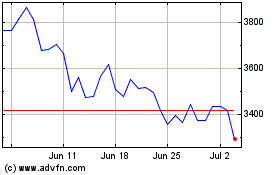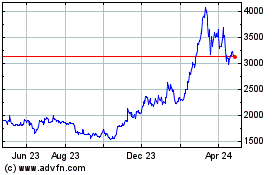Ikigai Founder Explains Why Bitcoin And Crypto Are ‘On The Verge Of Cannibalism’
June 19 2024 - 11:30AM
NEWSBTC
Travis Kling, Founder and Chief Investment Officer of Ikigai Asset
Management, shared his insights on the current state of Bitcoin and
the broader cryptocurrency ecosystem, which he described as
following: “Bitcoin is ~10% off of ATHs and the timeline appears to
be on the verge of cannibalism.” In a series of detailed posts on
X, Kling dissected the complex interplay of macroeconomic factors,
ETF flows, and internal market dynamics that are shaping the
cryptocurrency markets. Why Is Bitcoin Trading Flat? Kling began
his analysis by addressing Bitcoin’s performance relative to the
broader macroeconomic environment. Despite the NASDAQ surging 16%
since April 19, following a low induced by market trepidations
about rate cuts, Bitcoin has notably underperformed, remaining
relatively flat. Kling pointed out, “BTC is trading pretty crappy
relative to macro.” This underperformance is particularly striking
given that during this period, the US equity markets have
repeatedly set new all-time highs, while Bitcoin has stagnated.
Related Reading: Bitcoin Month-Long Rally Comes To An End: Price
Plunges Below $65,000 – What’s Next For BTC? A significant part of
Kling’s analysis focused on the dynamics of US spot Bitcoin ETFs.
Starting May 13, the market witnessed 19 consecutive days of robust
ETF inflows, totaling approximately $4 billion. Surprisingly, these
substantial inflows only resulted in a 17% increase in Bitcoin’s
price, which Kling argues is underwhelming. He noted, “It’s true
BTC was +17% over this period, but why not more? Why not
meaningfully higher highs?” This question points to underlying
issues in market structure or investor sentiment that might be
damping the expected bullish response to inflow
surges. Moreover, recent ETF outflows have coincided with a 7%
drop in Bitcoin’s price over a similar period, further complicating
the narrative around ETF impacts. Kling suggests that while ETF
inflows and outflows are significant, they might not fully capture
the underlying market dynamics, indicating a complex interplay of
arbitrage opportunities and market sentiment. “I think one thing we
can say with confidence is that the ETFs have a lot of arb flow in
them. Just look at the 13Fs. There’s NAV arb and then that gets
laid off into futures and spot and then there’s the same basis
trade that’s always been present in this market,” Kling wrote. He
also speculated about external factors affecting Bitcoin’s price,
such as potential government sales of Bitcoin confiscated during
the Silk Road operation. Although he admits lacking concrete proof,
Kling aligns his hypothesis with the timing of certain market
movements and known government actions. Additionally, he
highlighted the influence of Ethereum on Bitcoin’s market dynamics,
particularly during a week of significant activity around an
Ethereum ETF, which saw the largest weekly ETH to BTC volume on
record since a previous peak. What To Expect From Ether And
Altcoins? Despite Ethereum’s influence on Bitcoin, ETH itself faces
challenges. The anticipation surrounding spot Ethereum ETFs has not
translated into sustained positive price action. Ethereum remains
30% below its all-time high, with upcoming ETFs potentially being a
critical factor. Kling posits, “If [Ethereum ETF inflows] are
strong, ETH likely rips hard. If they’re weak, ETH may sell off.”
The uncertainty about the strength of these inflows and their
market impact reflects broader market anxieties. Related Reading:
Hard To Be “Too Scared Of Bitcoin Price Action,” Says Analyst.
Here’s Why The broader altcoin market is also suffering, with many
tokens significantly off their highs and struggling to find a
footing. Kling’s remarks about the altcoin sector are particularly
stark: “The airdrop meta has been dying a slow death for months.
Alts are overwhelmed with token unlocks from holders that are up
many multiples and will hammer a nonexistent bid.” This scenario
illustrates the difficulties facing smaller altcoins as they
navigate a market dominated by major players like Bitcoin and
Ethereum. In conclusion, Kling’s comprehensive analysis suggests a
cryptocurrency market at a critical juncture, facing internal
competition and macroeconomic mismatches that could define its
trajectory in the coming months. “So overall that’s what has the
timeline acting like prices are 75% lower than they are right now.
BTC is probably heading higher this year. ETH is probably somewhere
between fine and gangbusters this year, based on ETH ETF inflows.
But the gap between BTC/ETH and everything else is wide and likely
going to get wider this year. If crypto can muster up even a
modicum of a legit narrative that can drive real inflows into Alts,
it can all change in a hurry. But the current slate of ‘narratives’
is unlikely to get that done,” Kling concluded. At press time, BTC
traded at $65,138. Featured image from YouTube / What Bitcoin Did,
chart from TradingView.com
Ethereum (COIN:ETHUSD)
Historical Stock Chart
From Jun 2024 to Jul 2024

Ethereum (COIN:ETHUSD)
Historical Stock Chart
From Jul 2023 to Jul 2024
